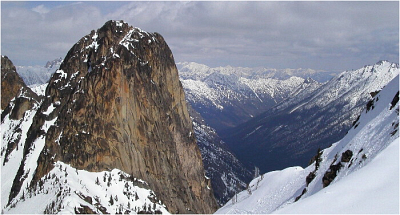South Early Winter Spire - Southwest Buttress, August 2005

It's been about three years since I climbed Liberty Bell; a return visit to the area was long overdue. This time, with Eric's unused 5-inch cam and a 4.5-inch cam borrowed from Martin at the very last minute, I set my sights for the Southwest Rib of South Early Winter Spire. Combining an 80ft 5.8 crack, a short 5.7 "bear-hug" pitch and an unexpectedly spicy, but short 5.6 slab move, the SW Rib is a fine climb of moderate difficulty, reaching the top of the tallest spire of the Liberty Bell Group. Considering the short approaches (usually no more than an hour), dry, warm Eastern Washington climate and numerous routes of quality on exquisite Washington Pass granite, this is also the kind of climbing I could easily get used to.
Following a worn climber's path, we somehow ignored the direct West Face start below the obvious 5.8 crack visible high on the rock, and blindly hiked up towards SEWS' Southwest Couloir. Content with beginning the climb from here, Eric and I racked up and started up towards the large chockstone low in the couloir. Once above the chockstone, we continued left up a vegetated rib (small pine trees) looking for some indication of a ledge leading "leftward and downward" with "small bushes and trees". Following an abundance of newer slings (with rap rings) tied around the small pines, I figured we were still on-route as I proceeded upwards on the rib. I found myself beneath a steep headwall a few moves later, and again looked left for that elusive ledge. Lo and behold, there it was - a very thin and exposed ledge that traverses high on the West Face to a comfortably shady nook at the belay station directly above the 80ft crack pitch...yes, above! Lame. I briefly considered rapping down to the ledge below us (the correct ledge, incidentally) so that we could actually climb the crack, but seeing as there was a party now making their way up the direct West Face start towards us, we decided to just proceed upwards. Lame.
So, our first real pitch of climbing would be the enjoyable, but short left-facing, mid-fifth corner crack to the next ledge. From there, the next pitch traverses to the right along the ledge around a corner, then up a slab with shallow cracks, thin holds and some run-out near the top (felt a bit spicy for the 5.6 rating). Belaying from the top of the slab, I next traversed out left towards the base of the 5.7+ "bear-hug" pitch (a pair of wide twin cracks). Placing the No.5 up as high as I could reach in the right crack, I hesitated to make that committing high-step and flailed for a while, now aware of the party below waiting and watching us to finish up the pitch. "Come on...pull yourself together man!" Ok, ok, it wasn't that bad really, but I wasn't entirely confident in the next 4.5" placement – both cracks flare a bit (suggest two 5's instead). Eric of course made short work of the "Bear-Hug" pitch...though being shorter than I; he had difficulty retrieving the first cam. Ha, so there!
Now stuffing the unneeded big pro in Eric's pack, I led out around a corner (look for hidden bolt in slab at left) for a long simul-climbing pitch of 4th and low 5th class rock directly on the crest of the Southwest Buttress. A deep notch at the "Rabbit Ears" can easily be bypassed via an exposed and licheny ledge at left. From there, one final short low-5th crack leads to the summit. Looking around from our perch high above Washington Pass, it was amusing to see every spire, from Liberty Bell to SEWS and everything in between, each with a party either on the summit or somewhere on-route. An "alpine cragging" paradise indeed! Satisfied with ourselves for the day, we weren't in any great hurry to squeeze-in any other routes and just relaxed in the sun, chatting with the other party on the summit.
The South Arete descent is a quick and dirty affair, with just one rappel down a deep chimney and another ad-hoc hand-line rappel down the final 20 feet or so (Eric managed to down-climb the last bit). With only a short hike remaining, we casually made our way back down to the trailhead and bid Washington Pass adieu for the season.
Click here to view photos.








